Poker is one of the most popular card games in the world. It’s played by millions of people, from casual players to professionals. Poker is a game of 🧠 strategy, psychology, and a bit of 🍀 luck. To enjoy poker and play it well, you need to understand the basic game rules. In this article, we will break down the basic rules of poker, focusing on the most common variation, Texas Hold’em. We’ll also cover some other popular poker variations, like Omaha and Seven-Card Stud.
We will describe all the poker rules in detail step-by-step in simple words. At the end, we’ll also provide you with a full hand example. We guarantee that you’ll have no more questions about poker rules after reading our article.
The Basics of Poker
Before diving into the specific rules of different poker games, let’s cover the basic concepts that apply to most poker variants.
Cash or Tournament Game Format
The classic poker game starts when 2 to 10 players sit at the real or online table. All the players get some chips to play with. The amount of chips a particular player has at the moment is called their “chip stack”. Initial chip stack sizes vary depending on the game format:
- In a 💵 Cash game, players can choose what chip stack they want to start a game with. They also can freely add chips to their stack between the hands. The only limit here is the minimum amount allowed to enter the game. It usually measures in big blinds (we’ll explain what that is later on), and the common minimum buy-in to a cash game is ~40BB. The typical chip stack professional players prefer to have in online cash games is 100BB.
- In a 🏆 Tournament, starting chip stacks are determined by tournament rules. So every player starts a game with the same amount of chips. Again, this amount usually depends on a tournament structure, around 20-100BB. The smaller the starting chip stack players have, the quicker the game goes. A bigger starting chip stack makes the game slower but brings more interesting pots and tough and expensive decisions for the players.
The Main Goal Of The Game
The goal in a poker game is to win chips or money by either 🚀 making the strongest combination, or 👺 convincing your opponents that you have one.
The Deck
Poker is usually played with a standard 52-card deck. The cards are ranked from high to low: Ace, King, Queen, Jack, 10, 9, 8, 7, 6, 5, 4, 3, and 2. In most games, the Ace can play the role of the highest or the lowest card in a combination.
Poker Hand Rankings
In poker, you need to make a combination of 5 cards. The rules of different poker variants regulate how many cards you can make a combination from, as well as how many cards are visible only to you and how many are available to all players (so-called “community cards”). Although these rules may differ depending on the type of poker, the names and rankings of the hands are universal for all variants.
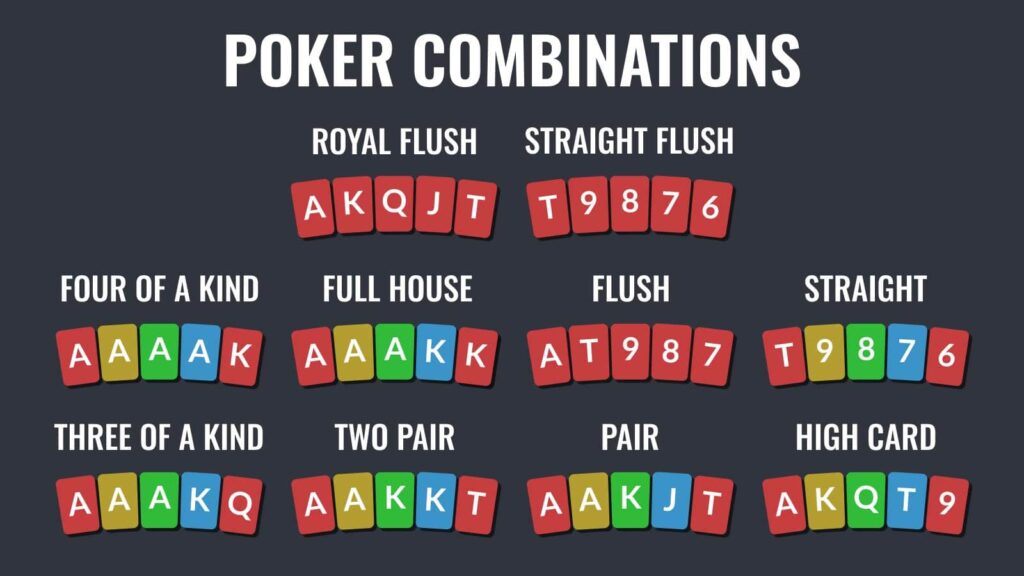
Here are all the possible poker combinations from highest to lowest:
- Royal Flush: A, K, Q, J, 10, all of the same suit.
- Straight Flush: Five consecutive cards of the same suit (e.g., 9, 8, 7, 6, 5 of hearts).
- Four of a Kind: Four cards of the same rank (e.g., 4 Aces).
- Full House: Three cards of one rank and two cards of another rank (e.g., three 8s and two 3s).
- Flush: Five cards of the same suit, not in sequence (e.g., 10, 7, 5, 3, 2 of diamonds).
- Straight: Five consecutive cards of different suits (e.g., 10 of clubs, 9 of diamonds, 8 of hearts, 7 of spades, 6 of hearts).
- Three of a Kind: Three cards of the same rank (e.g., three Jacks).
- Two Pair: Two cards of one rank and two cards of another rank (e.g., two Kings and two 5s).
- One Pair: Two cards of the same rank (e.g., two 10s).
- High Card: If no one has any of the above hands, the player with the highest card wins.
Betting
Poker games typically have several betting rounds or so-called “streets”. Players have the option to bet (wager), call (match a bet), raise (increase the bet), or fold (give up the hand). The betting continues until all remaining players have matched the highest bet or folded.
Betting limits define how much a player can bet or raise during a game. There are three common types of betting limits:
- ♾️ No Limit: Players can bet any amount, up to all their chips. This format opens doors for big bets and aggressive play.
- 📶 Pot Limit: The maximum bet is limited to the size of the current pot. This means players can bet an amount equal to what is already in the pot.
- ✋ Fixed Limit: Bets and raises are set at specific amounts. For example, in a $5/$10 fixed-limit game, bets and raises must be in $5 or $10 increments.
The number of betting rounds, their names, and the betting dynamics may differ in various types of poker. Below we will look at some of the most popular poker formats and break down the game mechanics for each of them.
Texas Hold’em Rules
Texas Hold’em is the most popular poker variant worldwide. It’s the game you see on TV and in most tournaments, movies, and shows. Let’s go through the Texas Holdem poker rules step by step.
So, 2 to 10 players are sitting at the table. The game type (cash or tournament) has already been determined. What next?
Dealer Button
Next, one of the players receives the dealer button. Initially, it goes to a random player. Furthermore, the dealer button will move to the next player to the left every hand.
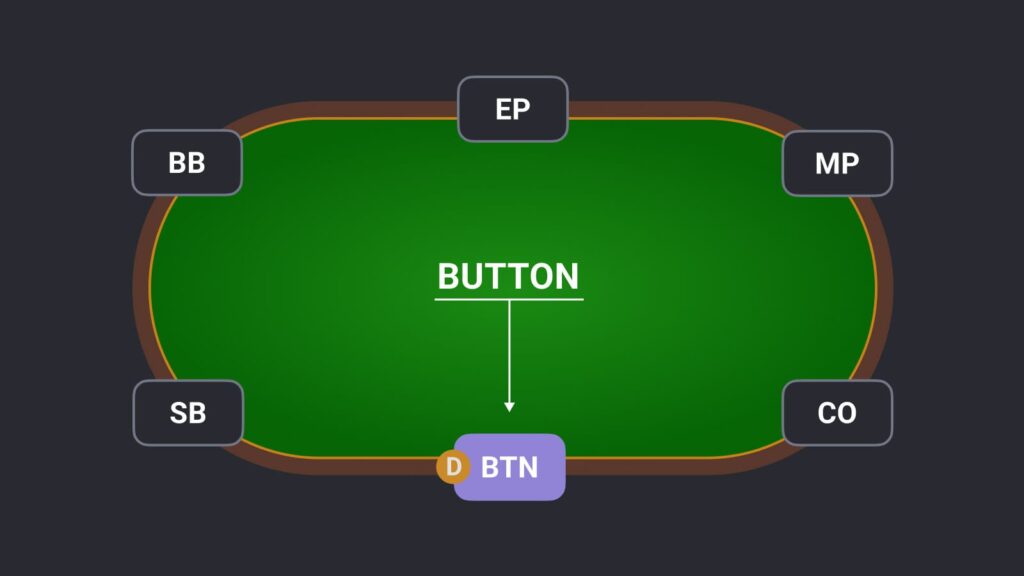
In home or casino games, to decide who has the button on the very first hand, the following procedure can be followed: Deal one card to each player. The player with the highest card gets the button. If there are two players with the same card rank, both players should receive one more card, so you can compare the ranks again, and so on. Eventually, one player will have the highest card, and they get a dealer button till the end of the current hand.
Dealer button has 2 main functions:
- 👉 In home games, the player with the dealer button is responsible for dealing cards in this hand. This rule doesn’t require to be followed strictly. If you have a player who would like to be a dealer for the entire evening, it’s fine – and maybe even better, because not all the players have the skills to shuffle the cards properly 😀. In casino games, you have a professional dealer at the table, who doesn’t participate in the hand, so the dealer button doesn’t play the role of a real “dealer” here.
- 👉 The second, and most important feature of a dealer button – it grants the “Button” position to the player who holds it. The Button is the strongest position in a poker game, so a player sitting in this position will have a position advantage during the hand.
Mandatory Blind Bets
After all the players sit at the table, and the button position is set, the next stage is posting mandatory bets. In the most popular poker format – Texas Holdem, two players have to make a “blind” bet before the hand starts. These two players are sitting to the left after Button, and their positions are called Small Blind (SB) and Big Blind (BB) correspondingly.
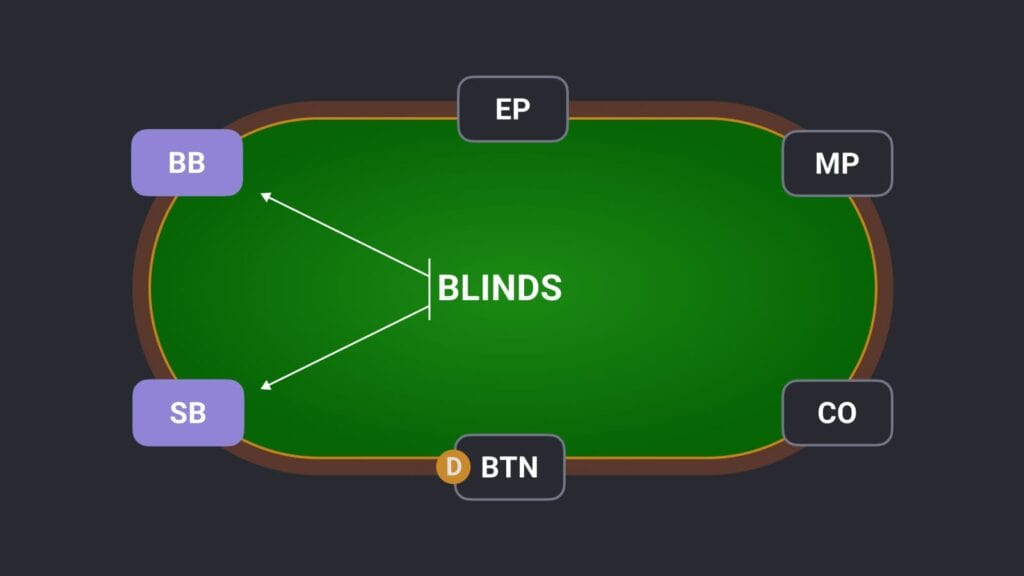
As you might understand from these names, these mandatory bets differ in size – there is a small one and a big one. The Small blind is usually a half of a Big blind. For example, if a big blind is 1$, the small blind will be $0.5.
Ante
An ante is a small, mandatory bet that all players must put into the pot before a hand of poker starts. Unlike blinds, which only two players pay, everyone at the table contributes to the ante. The amount is usually small compared to the other bets in the game. For example, if blinds are $0.5/$1, ante might be $0.1.
The purpose of the ante is to build a pot, ensuring there’s something to win in each hand. Antes encourage action because players have already invested money in the pot. They are common in tournaments and sometimes in cash games. However, the most classic Texas Holdem cash game is played without an ante.
Poker Table Positions
All the positions at the table have their own names and strategy nuances:
- 🔴 Early positions (Under the gun)
- 🟠 Middle positions (Low-jack, High-jack)
- 🟢 Late positions (Cutoff, Button)
- 🔵 Blinds (Small blind, Big blind).
In the picture below you can see the table with 6 players and all position names:
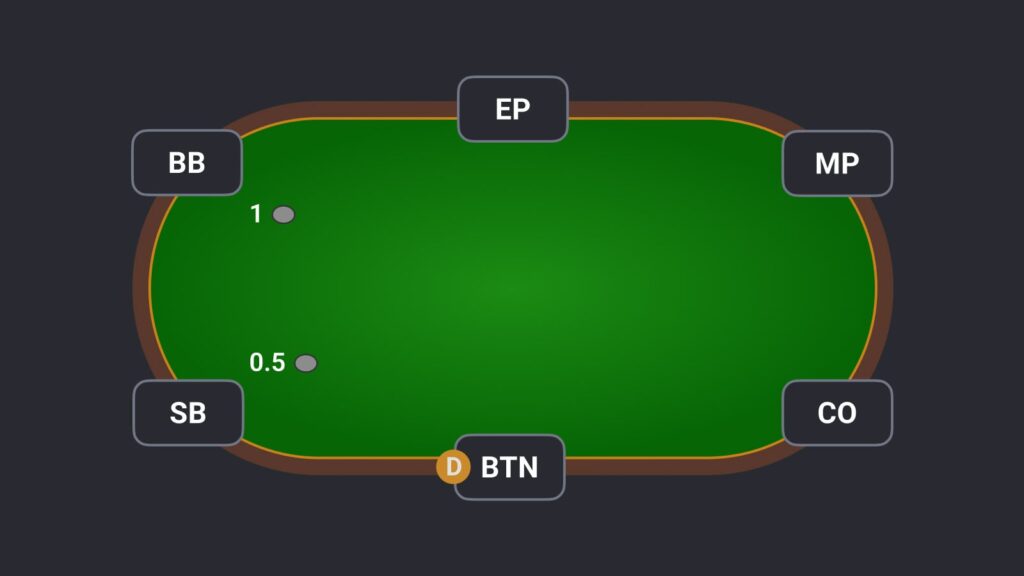
The button is set and blinds are posted, now the hand is ready to start. Shuffle up and deal!
Dealing the Cards
The dealer shuffles the deck and gives every player two private cards face down. These are the only cards each player will personally use.
The dealing process starts with the player in the Small Blind position – they get their first card, and then, clockwise, every player receives the card. Eventually, this circle goes back to Small Blind, they receive their second card, and we go clockwise again till all the players have two cards.
These two cards (often called “hole cards“) are your poker starting hand. You’ll hold it till the end of your presence in the hand.
Pocket aces A♥ A♦ is the best starting hand in Texas Holdem.
The hole cards represent the hidden part of your poker combination. Later on, the dealer will put 5 cards face-up on the table (often called “community cards”). All the players can use these 5 cards to complete their hands, so these cards will represent a visible part of your combination.
So your goal in the game is to build the strongest hand using the hole and community cards, or make your opponents believe that you have one.
Betting Rounds
Texas Hold’em poker variant has four betting rounds:
- Pre-Flop: After all players receive their hole cards, the first betting round begins. The player to the left of the big blind starts the betting. Players can fold, call the big blind, or raise.
- The Flop: After the first round of betting, the dealer deals three community cards face up on the table. These are called the Flop. A second round of betting begins starting with the player on the small blind. Or, if a small blind already left the hand, with the first active player to the left of the small blind position.
- The Turn: The dealer places a fourth community card face up on the table. This is called the Turn. Another round of betting begins. The player who starts the betting on the Turn is determined by exactly the same rules as on the Flop.
- The River: The dealer places the fifth and final community card face-up on the table. This is called the River. The final betting street.
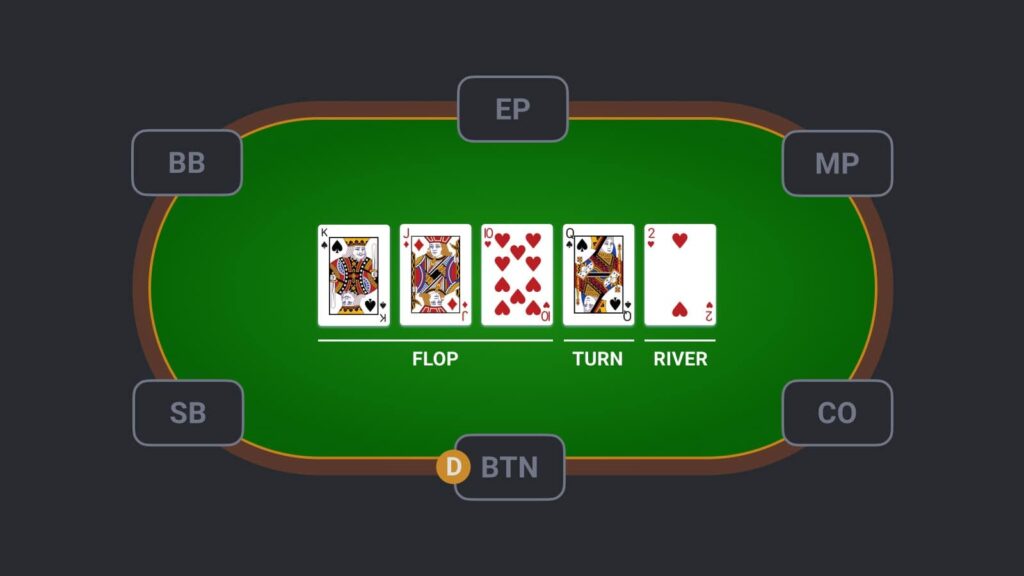
Actions
Here are the full list of actions you can do in poker when it’s your turn:
- 🏳️ Fold. Throwing away your hand and giving up. Your presence in the hand ends immediately, and you lose all the chips you already put in the pot.
- ⏩ Check. Skipping the action. If there were no bets before you, you can check and pass the action to the next player.
- ✅ Call. Matching the current bet. Allowing you to stay in the pot. Call is usually considered as a passive action, as you’re not putting pressure on your opponents, instead just paying the already set price to stay in the hand.
- ⚔️ Bet. Putting a certain amount of chips in the pot, challenging other players to either fold to your bet and leave the hand, or continue by calling or raising.
- 💣 Raise. Making a larger bet in response to the last maximum bet made in the current betting round. Raising is the most aggressive action in poker putting maximum pressure on other players.
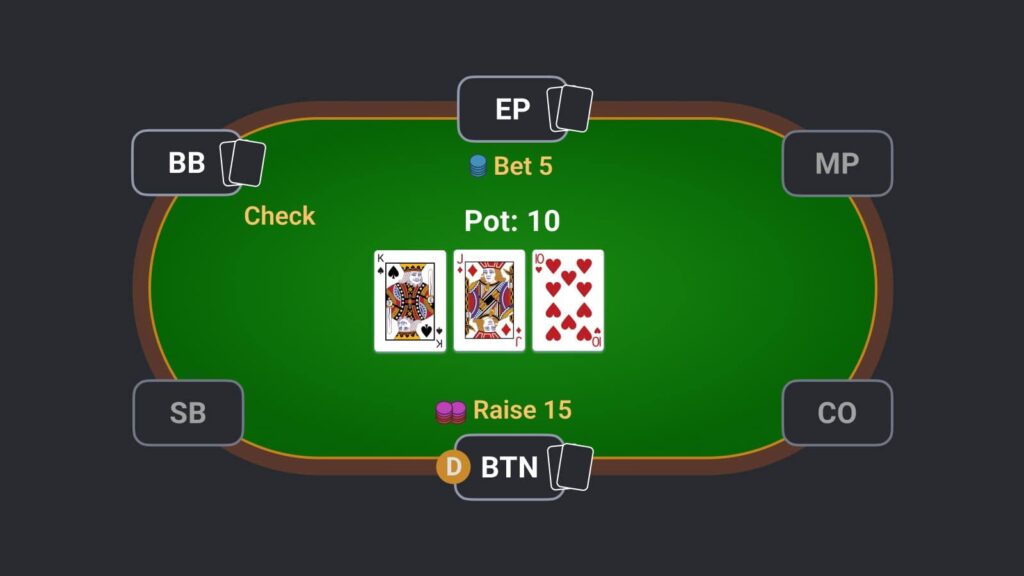
Showdown
After the final round of betting, if more than one player remains, there is a showdown. Players reveal their hole cards, and the best five-card hand wins the pot.
Note that not every hand goes to showdown. The hand could end earlier if one of the players aggressively knocked all opponents out of the pot. Some hands might even end Preflop if one player made a raise of such a size that no one else in the game dared to call.
Texas Hold’em Hand Example
Let’s have a look at a popular poker hand and break it down from a poker rules perspective.
Phil Ivey is on the Button. Sitting next to him, Daniel Negreanu and Tom Dwan put the blind bets, $800 and $1600 respectively. Then, cards are dealt.
The pre-flop action starts with Antonio Esfandiari in the Early position. He looks at K♣ 7♦ and decides to fold his hand. Next to act, Phil Laak, looks at A♠ 9♦ and makes a raise to $3900. Next, Eli Elezra makes the call with A♣ 7♣, matching the amount of this raise. So does Phil Ivey, also putting $3900 in chips to the pot holding A♦ 6♦. Daniel Negreanu looks at J♣ 3♣ and calls too. And then, Tom Dwan, who is acting the last in this round, decides to make a re-raise to $28,900 with 9♠ 8♠. The action goes clockwise next to the original raiser, Phil Laak, who now decides to give up against this raise. Elezra folds, Ivey makes the call, and Negreanu folds. Now the Preflop action is completed. There are two players left in hand and we go to the next betting round – Flop.
The Flop comes T♦ Q♣ K♦. Dwan has absolutely nothing. Ivey has only Ace-high, but he has a very good potential to improve his hand (he can get a flush or a straight with the right card on the next streets). Dwan puts a wager of $45,800 and Ivey calls.
The Turn card is 3♠. It changes nothing. Both players still don’t have any combination except for high-card. Dwan continues bluffing and bets $123,200. Ivey calls again hoping to improve his hand on the River.
The River brings 6♣ as the last community card. Phil Ivey makes a pair of sixes, while Dwan still has completely nothing. Dwan fires again with $268,200 bet. Ivey thinks for a while and decides to give up. Tom Dwan won the hand without a showdown round, so he doesn’t need to show his hand.
Now you fully understand how poker rules work for the Texas Holdem game. You can go play with friends or online in a poker room. And now it’s much easier for you to learn the rules of other formats, as there are a lot of similarities between all the poker variants.
Omaha Poker Rules
Omaha is another popular poker variant that’s similar to Texas Hold’em. The blinds, the betting rounds and hand rankings remain the same. The main difference is, that players receive not two but four hole cards at the beginning of the hand.
Another important thing is how players make their combinations. In Omaha, players must use exactly two of their hole cards and three of the community cards to make the best five-card hand. This is the key difference from Texas Hold’em, where players can use any combination of hole and community cards.
Omaha is usually played with the pot-limit betting structure. So players’ bets and raises are limited to the pot size. That’s why Omaha is often called Pot Limit Omaha, or simply PLO.
Recently, new formats of Omaha have also emerged where players are dealt 5 or even 6 cards. These formats are called “PLO 5 card” and “PLO 6 card” respectively. Apart from the number of hole cards, the rules of these games are no different from classic Omaha. PLO 5-6 might be more interesting for a new players as there are higher probability of making a strong combination. But don’t forget that it’s relevant for your opponents too 😀
Basic Poker Etiquette
Understanding the rules is important, but so is knowing how to conduct yourself at the poker table. Here are some basic poker etiquette tips:
- 🙌 Be polite: Treat other players with respect. Don’t criticize their play, even if you think they made a mistake.
- 🐌 Don’t slow roll: Slow rolling is when you have a winning hand but delay showing it to make your opponent think they have won. It’s considered bad sportsmanship.
- ⏳ Keep the game moving: Don’t take too long to make decisions. It slows down the game and can frustrate other players.
- 🤫 Don’t discuss hands while the hand is in progress: Don’t talk about what you folded or speculate on what others might have. It can influence the outcome of the hand. You’re free to discuss anything between the hands.
Remember doesn’t matter where you play – in a casino, on a poker site online table or in a home game – you should always follow these unspoken poker rules. This shows your respect for the game and your opponents.
Conclusion
Poker is a game of skill, strategy, and luck. Understanding the rules is the first step to becoming a successful poker player. Whether you’re playing Texas Hold’em, Omaha, Seven-Card Stud, or another variant, the key is to stay focused, make smart decisions, and have fun.
This guide provides a comprehensive overview of the basic rules of poker, but the best way to learn is to play. Start with friendly games with friends or family, or dive into online games right away.
Also, as you know the rules, you can now learn poker strategy with the help of training articles and videos. We recommend you start from a deeper understanding of whether 🤔 poker is a game of skill or luck.
Remember, poker is not just about winning; it’s about enjoying the game and challenging yourself. Good luck at the tables!